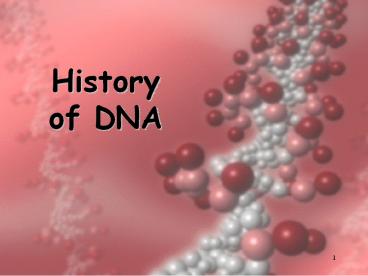History of DNA - PowerPoint PPT Presentation
1 / 35
Title:
History of DNA
Description:
History of DNA * * Translation Translation is the process of of decoding the mRNA into a polypeptide chain Ribosomes read mRNA three bases or 1 codon at a time and ... – PowerPoint PPT presentation
Number of Views:127
Avg rating:3.0/5.0
Title: History of DNA
1
History of DNA
2
History of DNA
- Chromosomes are made of coiled DNA and protein
- Experiments on bacteriophage viruses by Hershey
Chase proved that DNA was the cells genetic
material
3
DNA Structure
- Rosalind Franklin took diffraction x-ray
photographs of DNA crystals - In the 1950s, Watson Crick built the first
model of DNA using Franklins x-rays- double helix
4
DNA Structure
5
DNA
- Two strands coiled called a double helix
- Sides made of a pentose sugar Deoxyribose bonded
to phosphate groups - Center made of nitrogen bases bonded together by
weak hydrogen bonds
6
DNA Double Helix
7
DNA Nucleotide
8
Pentose Sugar
- Sugars are numbered clockwise 1 to 5
9
Chargaffs Rule
- Adenine must pair with Thymine
- Guanine must pair with Cytosine
- The bases form weak hydrogen bonds
10
Nitrogenous Bases
- Double ring PURINES
- Adenine (A)
- Guanine (G)
- Single ring PYRIMIDINES
- Thymine (T)
- Cytosine (C)
11
DNA
12
Antiparallel Strands
- One strand of DNA goes from 5 to 3 (sugars)
- The other strand is opposite in direction going
3 to 5 (sugars)
13
Question
- What would be the complementary DNA strand for
the following DNA sequence? - DNA 5-CGTATG-3
14
Answer
- DNA 5-GCGTATG-3
- DNA 3-CGCATAC-5
15
DNA and Genes
16
DNA
- DNA contains genes, sequences of nucleotide bases
- These Genes code for polypeptides (proteins)
- Proteins are used to build cells and do much of
the work inside cells
17
Polypeptides
- Amino acid chains are called polypeptides
18
DNA Begins the Process
- DNA is found inside the nucleus
- Proteins, however, are made in the cytosol of
cells by organelles called ribosomes - Ribosomes may be free in the cytosol or attached
to the surface of rough ER
19
Starting with DNA
- DNA s code must be copied(transcription) and
taken to the cytosol - In the cytosol, this code must be
read(translation) so amino acids can be assembled
to make polypeptides(proteins) - This process is called PROTEIN SYNTHESIS
20
RNA
21
RNA Differs from DNA
- RNA has a sugar ribose
- DNA has a sugar deoxyribose
22
Other Differences
- RNA contains the base uracil (U)
- DNA has thymine (T)
- RNA molecule is single-stranded
- DNA is double-stranded
DNA
23
Types of RNA
.
- Messenger RNA (mRNA) copies DNAs code carries
the genetic information to the ribosomes - Transfer RNA (tRNA) transfers amino acids to the
ribosomes where proteins are synthesized - Ribosomal RNA (rRNA)
24
Messenger RNA
- Long Straight chain of Nucleotides
- Made in the Nucleus
- Copies DNA
- Contains the Nitrogen Bases A, G, C, U ( no T )
- Sequence of 3 bases called codon
25
Transfer RNA (tRNA)
- Clover-leaf shape
- Single stranded molecule with attachment site at
one end for an amino acid - Opposite end has three nucleotide bases called
the anticodon
26
Codons and Anticodons
- The 3 bases of an anticodon are complementary to
the 3 bases of a codon - Example Codon ACU
- Anticodon UGA
UGA
ACU
27
The Genetic Code
- A codon designates an amino acid
- An amino acid may have more than one codon
- There are 20 amino acids, but 64 possible codons
28
The Genetic Code
- Use the code by reading from the center to the
outside - Example AUG codes for Methionine
29
Transcription and Translation
30
Transcription
- The process of copying the sequence of one strand
of DNA, the template strand - mRNA copies the template strand
- Requires the enzyme RNA Polymerase
- Occurs in the nucleus
31
Template Strand
32
Question
- What would be the complementary RNA strand for
the following DNA sequence? - DNA 5-GCGTATG-3
33
Answer
- DNA 5-GCGTATG-3
- RNA 3-CGCAUAC-5
34
Translation
- Translation is the process of of decoding the
mRNA into a polypeptide chain - Ribosomes read mRNA three bases or 1 codon at a
time and construct the proteins - Occurs in the cytoplasm
35
Transcription
Translation































